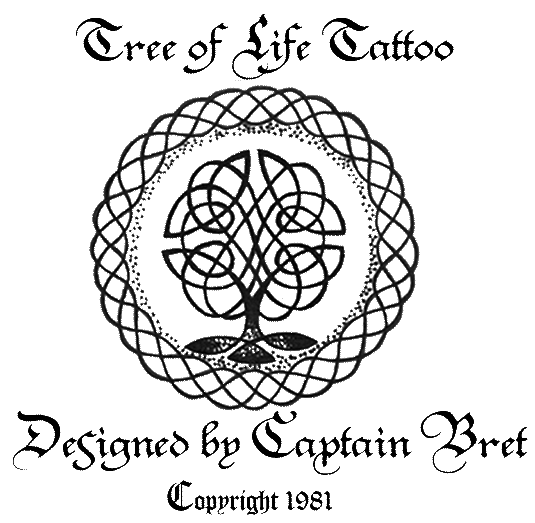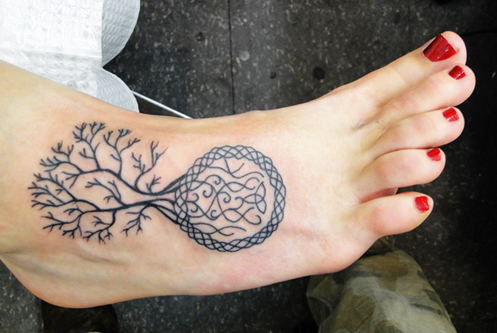Tree Of Life Tattoos For Women
One tattooed Mummy (c. 300 BC) was extracted from the permafrost of Altaï in the second half of the 15th century (the Man of Pazyryk, during the 1940s; one female mummy and one male in Ukok plateau, during the 1990s). Their tattooing involved animal designs carried out in a curvilinear style. The Man of Pazyryk, a Scythian chieftain, is tattooed with an extensive and detailed range of fish, monsters and a series of dots that lined up along the spinal column (lumbar region) and around the right ankle (illustrated at right).
Tattooing was popular among many ethnic minorities in China since ancient time. However, among the Han Chinese (the major ethnic group) Tattoo has been associated with barbaric, criminals, gangsters and bandits since at least Zhou Dynasty (1045 BC to 256 BC). Tattooing Chinese character "Prisoner" (囚) or other characters on convicted's or slave's face was a practice until the last dynasty Qing Dynasty (1644 to 1912).
Tattooing has been featured in one of the Five Classic Novels in Chinese literature, Water Margin, in which at least three of the 108 characters, Lu Zhi shen (鲁智深), Shi Jin (史進) and Yan Ching (燕青) are described as having tattoos covering nearly the whole of their bodies. Wu Song (武松) has tattoo on his face due to killing Xi Men Qing (西门庆) with vengeance. In addition, Chinese legend has it that the mother of Yue Fei (岳飛), the most famous general of the Song Dynasty, tattooed the words jing zhong bao guo (精忠報國) on his back with her sewing needle before he left to join the army, reminding him to "repay his country with pure loyalty".
Marco Polo wrote of Quanzhou "Many come hither from Upper India to have their bodies painted with the needle in the way we have elsewhere described, there being many adepts at this craft in the city."
The traditional Han Chinese view especially Confucianism believes that the body is a gift of parents and continuation of the bloodline of the ancestors. Damaging the body is a grave offense. Tattooing and piercing (except women's ear piercing) are generally not accepted by the community. This view can be reflected by the fact that many Han Chinese was killed at the beginning of Qing Dynasty when they refuse to obey the Manchu government's order that all Han Chinese men to shave their forehead (the Manchu hair style), see "Queue Order".
Henna and Mehndi were popular in ancient India and ancient Egypt and still remain popular today in the Indian subcontinent, Middle East and North Africa.
Tattooing has been a part of Filipino tribal life since pre-Hispanic colonisation of the Philippine Islands, When the Spanish first landed in the Philippine Islands, they were met by the tribal people of the Visayas, who had full body tattooing, the Spanish dubbed these Islands as "La Isla De Los Pintados" or "The Island of the Painted Ones". Tattooing in the Philippines is a tribal form of rank and accomplishments, some tribes believed that tattoos had magical qualities. The more famous tattooed Filipino tribes where the tribal peoples of the mountains of North Luzon, especially among the Bontoc Igorot, Kalinga, and Ifugao peoples, which were infamous for Head-hunting. A tribal member received a tattoo (known as a "Chaklag") which meant they have taken the head of an enemy tribe or warrior. There are many very different variations, traditions and styles of tattooing in the Philippines, most depend on the region and tribe they come from as each vary.
Filipino tattooing was first documented by the European Spanish explorers as they landed among the Islands in the late 16th century. Before European exploration it was a widespread tradition among the islands. Tattooing was set around mostly Tribal groups of the Philippines, which tattooing was a sign of Rank and power in the tribal community, many Tattoos could only be attained by accomplishing a task, or passage of rites. Women in Filipino tribal society also traditionally tattooed themselves, and tattooing was seen as a form of beauty among women. Notably women of the Luzon mountain tribes received full arm and chest tattooing, whilst in the Visayas and Mindanao they typically only tattooed their hands and wrists. Several Indonesian tribes have a tattoo culture. One notable example is the Dayak people of Kalimantan in Borneo (Bornean traditional tattooing). Pre-Christian Germanic, Celtic and other central and northern European tribes were often heavily tattooed, according to surviving accounts. The Picts were famously tattooed (or scarified) with elaborate dark blue woad (or possibly copper for the blue tone) designs. Julius Caesar described these tattoos in Book V of his Gallic Wars (54 BCE).
Tattooing was popular among many ethnic minorities in China since ancient time. However, among the Han Chinese (the major ethnic group) Tattoo has been associated with barbaric, criminals, gangsters and bandits since at least Zhou Dynasty (1045 BC to 256 BC). Tattooing Chinese character "Prisoner" (囚) or other characters on convicted's or slave's face was a practice until the last dynasty Qing Dynasty (1644 to 1912).
Tattooing has been featured in one of the Five Classic Novels in Chinese literature, Water Margin, in which at least three of the 108 characters, Lu Zhi shen (鲁智深), Shi Jin (史進) and Yan Ching (燕青) are described as having tattoos covering nearly the whole of their bodies. Wu Song (武松) has tattoo on his face due to killing Xi Men Qing (西门庆) with vengeance. In addition, Chinese legend has it that the mother of Yue Fei (岳飛), the most famous general of the Song Dynasty, tattooed the words jing zhong bao guo (精忠報國) on his back with her sewing needle before he left to join the army, reminding him to "repay his country with pure loyalty".
Marco Polo wrote of Quanzhou "Many come hither from Upper India to have their bodies painted with the needle in the way we have elsewhere described, there being many adepts at this craft in the city."
 this Tree of Life Tattoo |  Tree of Life Tattoo by Captain |  Cherry Blossom Tree Tattoo |  Tree of Life Tattoo Designs |  No wonder tree tattoos are so |
 Tree of Life Tattoo Designs |  Tree Of Life Tattoo Design For |  The Celtic tree of life tattoo |  Tree of Life Tattoo Designs |  Tattoo of Tree without Leaves |
Tattooing has been a part of Filipino tribal life since pre-Hispanic colonisation of the Philippine Islands, When the Spanish first landed in the Philippine Islands, they were met by the tribal people of the Visayas, who had full body tattooing, the Spanish dubbed these Islands as "La Isla De Los Pintados" or "The Island of the Painted Ones". Tattooing in the Philippines is a tribal form of rank and accomplishments, some tribes believed that tattoos had magical qualities. The more famous tattooed Filipino tribes where the tribal peoples of the mountains of North Luzon, especially among the Bontoc Igorot, Kalinga, and Ifugao peoples, which were infamous for Head-hunting. A tribal member received a tattoo (known as a "Chaklag") which meant they have taken the head of an enemy tribe or warrior. There are many very different variations, traditions and styles of tattooing in the Philippines, most depend on the region and tribe they come from as each vary.
 tree tattoo |  Still, it\x26#39;s a good tattoo, |  Tree tattoos that focus on |  Tree Tattoo for Young Girls |  Tree Of Life Tattoos 21 M Girl |
 Autism Dove Tattoo |  Tree of Life Tattoo Designs |  Cherry Blossom Tattoo Pictures |  Tree of Life Tattoo Design |  Tree Of Life Tattoo Design For |

0 Comments:
Post a Comment
Subscribe to Post Comments [Atom]
<< Home